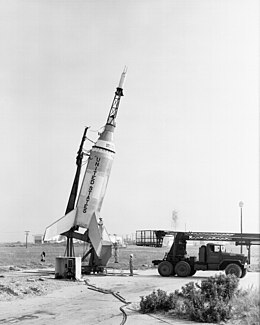Little Joe 1

Little Joe 1 prepares for launch
|
|
| Mission type | Abort test |
|---|---|
| Operator | NASA |
| Mission duration | 20 seconds |
| Distance travelled | 0.80 kilometres (0.5 mi) |
| Apogee | 0.61 kilometres (2,000 ft) |
| Spacecraft properties | |
| Spacecraft type | Mercury boilerplate |
| Manufacturer | McDonnell Aircraft |
| Launch mass | 1,159 kilograms (2,555 lb) |
| Start of mission | |
| Launch date |
August 21, 1959 Launch Escape System fired 30 minutes before planned launch |
| Rocket | Little Joe |
| Launch site | Wallops LA-1 |
| End of mission | |
| Landing date | August 21, 1959 |
|
Project Mercury
Abort Tests |
|
Little Joe 1 (LJ-1) was a failed launch of a Little Joe solid fuel rocket that was designed to test the Mercury spacecraft Launch Escape and Recovery systems. The vehicle was 48 ft (15 m) in height, weighed approximately 43,000 lb (20,000 kg), and was 80 in (2.0 m) in diameter with a fin span of 21.3 ft (6.5 m). The Little Joe booster consisted of four Pollux and four Recruit clustered, solid-fuel rockets, could develop a thrust of 250,000 lbf (1,100 kN), and could lift a maximum payload of 3,942 lb (1,788 kg). The escape system, using a Grand Central 1KS52000 rocket motor, weighed 1,015 lb (460 kg).
On August 21, 1959, LJ-1 was being prepared for launch from the Wallops Flight Facility, Wallops Island, Virginia. Suddenly, about a half-hour before the scheduled launch, the escape rocket fired and pulled the Mercury spacecraft away from the launch pad. The spacecraft reached an apogee of 2,000 ft (610 m) and landed about 2000 feet away. The flight time was 20 seconds.
According to the Sept. 18, 1959 accident report, the unexpected triggering of the launch escape system was caused by a transient or electrical leak; analysis showed it to be due to the rapid-abort system being wired directly into the destruct arming busbar. The batteries were shipped from England to the U.S. uncharged and shorted; on charging at the pad, the batteries, when enough charge was reached, actuated the sequencer for the abort system, and sensing insufficient altitude, fired the squibs in the abort motor. Insufficient power in the batteries then failed to initiate the tower jettison motor and capsule parachute recovery charge, and both crashed into the sea.
...
Wikipedia

